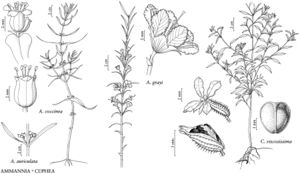Cuphea viscosissima
Hort. Bot. Vindob. 2: 83, plate 177. 1772.
Herbs annual, 1–6 dm, with fibrous-roots. Stems erect to decumbent, often reddish, much-branched, purple-red glandular-setose, glandular-viscid. Leavesopposite, petiolate; petiole (2–) 5–15 (–20) mm; blade narrowly lanceolate to narrowly ovate, 20–50 × 6–20 mm, base attenuate. Racemes leafy. Pedicels 1–5 mm. Flowers alternate, solitary, interpetiolar, sometimes with 1 axillary; floral-tube pale abaxially, deep purple-red adaxially, 8–12 × 1–2 mm, purple-red glandular-setose; base rounded or a descending spur, 0.5–1 mm; inner surface glabrous proximally, densely villous distal to stamens; epicalyx segments thick, 2 flanking the adaxialmost sepal terminated by a bristle; sepals unequal, adaxialmost longer; petals 6, purple, oblanceolate, unequal, 4 abaxial petals 2–5 × 0.4–0.6 mm, 2 upper petals 3–6 × 1.5–2.5 mm; stamens (5–) 11, reaching or surpassing sinus of sepals. Seeds 7–10, oblongelliptic in outline, 2.3–2.8 × 1.8–2.3 mm, margin rounded. 2n = 12.
Phenology: Flowering summer–fall.
Habitat: Weedy in pastures, roadsides, ditches, grassy borders, disturbed moist woods along trails.
Elevation: 0–900 m.
Distribution
Ont., Ala., Ark., Conn., Del., D.C., Fla., Ga., Ill., Ind., Iowa, Kans., Ky., La., Md., Mass., Miss., Mo., Nebr., N.H., N.J., N.Y., N.C., Ohio, Okla., Pa., S.C., Tenn., Tex., Vt., Va., W.Va.
Discussion
Cuphea viscosissima of the eastern and central United States is the most common and widespread species of Cuphea in the flora area; it is naturalized in Ontario. It is closely related to C. lanceolata W. T. Aiton of eastern and central Mexico, with which it shares the lowest known chromosome number in the genus, 2n = 12. The stamen number is typically 11, but varies in some populations (W. H. Duncan 1950).
Cuphea petiolata (Linnaeus) Koehne is an illegitimate name that pertains here.
Selected References
None.
